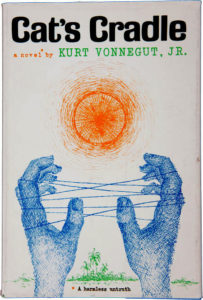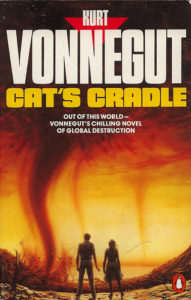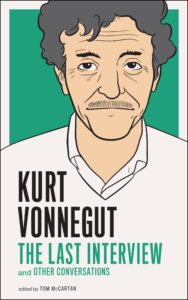See the “Twenty Writers, Twenty Books” home page for more information on this series as well as a list of other books and authors

Scholars elevate Slaughterhouse-Five as Kurt Vonnegut’s greatest literary achievement. Readers gravitate toward the warm embrace of God Bless You, Mr. Rosewater. For me, Vonnegut’s masterpiece is Cat’s Cradle. It belongs on the shelf beside 1984 and Invisible Man as one of the great novels of the 20th century.
Yet it’s a crime to call Cat’s Cradle a novel when it’s so much more. It’s less a work of fiction than Vonnegut laying down brick-by-brick his idiosyncratic worldview, a worldview he spent a lifetime attempting to communicate to his readership. I say “attempt” because I’m unsure Vonnegut will ever truly be widely understood. Scholars and readers will be decoding his work three hundred years from now…assuming there’s any life left on this planet.
Most summaries of Cat’s Cradle will home in on topics like nuclear annihilation, existentialism, the role of Big Science in postwar America, and postmodernism and metafiction. The book orbits around all those topics of course, but it’s primary concern is a fictional religion called Bokononism, possibly the only legitimate secular religion ever invented. Make no mistake: Vonnegut’s phony Bokononism is the heart of Cat’s Cradle. You can hear its theology beating on every page.
“Secular religion” comes off sounding pretentious and self-consciously contradictory. My “legitimate” qualifier does little to shore up my praise for Vonnegut’s work. I choose these words carefully.
For context, secular religions were a booming cottage industry in mid-twentieth century America. 1950s and 1960s America is often viewed (or derided) as orderly, pious, and gray. Look again; freshly-minted religions based on pseudo-psychiatry and pseudoscience flourished in the 1950s among the upper-middle- and upper-classes seeking release from restrictive Judeo-Christian morality. A decade later, their teenage children would likewise search for escape from their dreary petite bourgeois existence among the raft of America’s invented religions.
Consider Unitarian Universalism. Founded in 1961, it espouses “no shared creed” among its adherents and draws upon Western and Eastern religions of all stripes for guidance. Eckankar (1965) states its religion’s name means “co-worker with God” and teaches its adherents how to achieve out-of-body experiences.
More sinister additions to America’s theologically-loose religions are Scientology (1952), Synanon (1958), Jim Jones’ Peoples Temple (1955), The Process Church of the Final Judgment (1966), even Charles Manson’s Family—the list of so-called New Religions in post-World War II America is staggering.
(Yes, many of these so-called secular religions dabble with a higher power, but on closer inspection the theology is window-dressing for more earthly philosophies. For example, The Church of Satan does not believe in a supernatural Satan.)
This is the zeitgeist Vonnegut was writing into when he produced Cat’s Cradle in 1963. While he’s properly regarded as a satirist, his faux religion in Cat’s Cradle is not a literary device for poking fun at God or devotion. It should not be considered a parody-religion like The Church of the SubGenius or that Spaghetti Monster joke. The humorous tenets and terminology of Bokononism are laid-out with absolute dead-pan conviction—an earnest joke, the first open-source religion with the source code being Cat’s Cradle itself and the sacred communion being laughter. Vonnegut expected no one to convert to his religion, but it’s apparent he hoped his readers would at least take its teachings to heart. If they didn’t—well, so it goes.
The contradiction of Bokononism is not that it’s a secular religion. The contradiction is that it was proposed by an atheist who distrusted scientists as much as he distrusted clergy, a man who found consolation in, of all things, religion. The final sentence of Cat’s Cradle is the final sentence of the Books of Bokonon: “If I was a younger man, I would write a book about human stupidity.” Vonnegut did just that.
Call me Jonah
Cat’s Cradle opens with the narrator (“Call me Jonah”) at work on a non-fiction book called The Day the World Ended. It’s to be a collection of interviews with various famous people discussing what they were doing the day America dropped the atom bomb on Hiroshima. In the course of making inquiries he’s introduced to the family of Dr. Felix Hoenikker, an absentminded scientist who worked on the A-bomb project. From there the narrator’s life begins to spin in crazy directions as he finds himself caught up in Caribbean politics, Big Science, a new form of water, and, of course, Bokononism, Vonnegut’s secular religion.
Big Science is represented in Cat’s Cradle by the research arm of the General Forge and Foundry Company, a stand-in for General Electric. There the narrator is introduced to one of Dr. Hoenikker’s lesser-known scientific discoveries: Ice-Nine, the most famous fictional device to emerge from Cat’s Cradle.
(Vonnegut briefly worked for GE in the 1950s. The character of Dr. Felix Hoenikker is based on a scientist employed there, Dr. Irving Langmuir, who died before the book was written.)
A single flake of Ice-Nine will “teach” all water it comes in contact with how to freeze and remain frozen at room temperature. Those water molecules will, in turn, teach all liquid water they come in contact with to freeze as well, and on and on. (Ice-Nine is real; the version Vonnegut describes is not.) Dr. Hoenikker thought he was solving a practical problem of allowing Marines to cross swamps and lakes without being mired down in the mud. However, if a molecule of Ice-Nine were to make contact with, say, the Pacific Ocean, it would teach all the water in the world to freeze and bring life on this planet to an end. Perverse outcomes due to the actions of well-meaning individuals is a common theme in Vonnegut’s work (Mother Night, Jailbird), and it’s certainly a healthy component of Cat’s Cradle.
While writing his book on the end of the world, the narrator travels to the fictional island of San Lorenzo to interview one of Dr. Hoenikker’s grown children who is now second-in-command of the entire island. There the narrator is introduced to Bokononism, a religion indigenous to San Lorenzo.
By Vonnegut’s own telling the religion started as a sham. It was concocted by two shipwrecked passengers during World War I in order to control the indigenous peoples of San Lorenzo. One of the passengers, a U.S. Marine deserter, made himself the dictatorial President of San Lorenzo while the other took the role of pauper-philosopher Bokonon, who began crafting his religion from whole cloth. The chain reaction of Ice-Nine “teaching” every molecule of water it touches to become more Ice-Nine mirrors the way Bokononism spreads.
As Vonnegut later remarked:
Q: Did the study of anthropology later color your writings?
Vonnegut: It confirmed my atheism, which was the faith of my fathers anyway. Religions were exhibited and studied as the Rube Goldberg inventions I’d always thought they were. We weren’t allowed to find one culture superior to any other. We caught hell if we mentioned races much. It was highly idealistic.
Q: Almost a religion?
Vonnegut: Exactly. And the only one for me. So far.
Although Bokononism arrives late in Cat’s Cradle, the narrator has been discussing it since page one. He’s often discussing Bokononism without the reader being aware of it. The narrator’s late conversion to Bokononism has fitted him with new glasses to see afresh the events of his own life and the world at large. As I said, the religion’s theology beats on every page of the book.
“Shameless lies”
While a made-up religion may be the focal point of Cat’s Cradle, the reach of this slender novel is far broader: Ice-Nine, Big Science, the history of the atom bomb, the history of a fictional Caribbean nation, Cold War politics, and more. Vonnegut ably covers all this territory over the course of 127 chapters (!), some only a few paragraphs long. My copy of Cat’s Cradle clocks in at a mere 191 pages, and that’s a pocket-sized mass market edition. Each chapter comes close to standing alone, a necklace of koans strung together in such a way to reveal greater truths.
While Vonnegut is recognized as one of the great writers of the last century, he’s not particularly well-regarded for his use of language, which is often received as plain or unadorned. I think Vonnegut’s prose is wildly underrated. Vonnegut was in possession of a finely-tuned bullshit detector. He was so attuned to honesty in writing (in his own and others’) that I believe he couldn’t bear to lard down his work for style points. His direct manner and careful choice of words is Vonnegut’s style. Anyone who attempts to imitate him, beware: it’s not a pose, it’s a way of thinking.
In Cat’s Cradle Vonnegut’s prose is at its best (yes, even better than Slaughterhouse-Five). He produces some of the most economical and expressive scenes in his entire body of work. Here the narrator examines one of the Hoenikker children’s model railroad dioramas:
And then he turned on a switch, and the far end of the basement was filled with a blinding light.
We approached the light and found that it was sunshine to a fantastic little country built on plywood, an island as perfectly rectangular as a township in Kansas. Any restless soul, any soul seeking to find what lay beyond its given boundaries, really would fall off the edge of the world.
The details were so exquisitely in scale, so cunningly textured and tinted, that it was unnecessary for me to squint in order to believe that the nation was real—the hills, the lakes, the rivers, the forests, the towns, and all else that good natives everywhere hold so dear.
And everywhere ran a spaghetti pattern of railroad tracks.
This is not Hemingwayesque tough-guy economy but the economy of describing a rather involved bit of scene and symbol with a modicum of words. (The child who built this model island would grow up and become second-in-charge of another island-in-miniature, San Lorenzo.) The language may not be impressive, but it wasn’t designed to be impressive. Vonnegut manages to describe all of Cat’s Cradle‘s intricate clockwork in a handful of pages because he’s boiled down his scenes with terse concision. The payoff is a readable, approachable book discussing a lot of big, abstract concepts.

Many paperback editions of Cat’s Cradle play up the apocalyptic science-fiction aspects of the novel without acknowledging the gallows humor and whimsical nature of Vonnegut’s world.
The succinct koan-like chapters reflect the contradictory nature of Bokononism. McCabe’s first edict upon taking power as President of San Lorenzo was a strict ban on Bokononism itself. This means, of course, everyone on the island practices Bokononism, including the President. The “dynamic tension” of absolute martial law versus an illicit but freeing religion keeps the people preoccupied. “All of the true things I am about to tell you are shameless lies” reads the first line of the Books of Bokonon, perhaps an opening sentence Vonnegut considered for Cat’s Cradle itself. This is how the book folds in on itself: the religion it describes permeates the telling of the novel rather than being a crude device to express some ideas.
While Ice-Nine is the most powerful symbol to emerge from Vonnegut’s book, the child-like language of Bokonon’s concepts are also famous. A karass is a group of people cosmically linked for some greater purpose (although they might not realize it), while a granfalloon is a false karass (like Hoosiers or Democrats). A vin-dit is a “sudden shove in the direction of Bokononism.” Perhaps the most important Bokononian concept is foma, “harmless untruths” which serve a more important goal.
“Tiger got to hunt, bird got to fly;
Man got to sit and wonder, ‘Why, why, why?’
Tiger got to sleep, bird got to land;
Man got to tell himself he understand.”
Let’s face it: Bokononism is a pretty thin theology compared to the rich wisdom of the Jewish midrash, the teachings of Jesus, or the scope of Buddhism. And for every surprising observation Vonnegut tosses effortlessly at the reader, he pairs it with a circus-style joke, such as the Bokononist foot fetish. Compared to the world’s major religions, an exegesis of Bokononism would not be a terribly long tract. It might not be much longer than Cat’s Cradle. And perhaps that’s the point.
Much of Bokononism centers around discovering one’s purpose in life and the people who share that purpose with you. The funny names for Bokonon’s concepts—wrang-wrang or wampeter—playfully mask deeper and more serious human dilemmas. Bokononism is concerned with ideals like happiness, acceptance, and forgiveness. It makes a point to single out those who stand in the way of those ideals, the greedy, intemperate, and spiteful. Bokonon’s theology may be as simple as this: Be a part of the solution rather than a part of the problem. Or, going back to Vonnegut’s anthropology studies: We are sadly far more alike than we want to believe.
 The only misstep I find with Vonnegut’s religion is the (perversely) celebrated saying Bokononists utter when they commit suicide: “Now I will destroy the whole world.” While it plays into the major concerns of Cat’s Cradle, I find the self-centeredness of the statement uncharacteristic of the rest of the religion, and indeed the entire book.
The only misstep I find with Vonnegut’s religion is the (perversely) celebrated saying Bokononists utter when they commit suicide: “Now I will destroy the whole world.” While it plays into the major concerns of Cat’s Cradle, I find the self-centeredness of the statement uncharacteristic of the rest of the religion, and indeed the entire book.
In his final interview before his death, Vonnegut noted
…I don’t mock religion at all. It’s very helpful to people. … I am enormously influenced by the Sermon on the Mount.
Cat’s Cradle returns to the concept of fomas repeatedly, the “harmless lies” we tell ourselves to make us happy. If harmless lies keep us from hurting one other, then perhaps we should be lying to ourselves even more. This is the price of peace.
Postscript: “Busy, busy, busy”
I find it appropriate that the Dell pocket edition I’ve owned since junior high school contains a major typo in the front matter, apparently the result of a confused typesetter:
For Kenneth Littauer,
a man of gallantry and taste.
–The Books of Bokonon, 1.5
*Harmless untruthsNothing in this book is true.
“Live by the foma* that make you brave
and kind and healthy and happy.”
Read through it one more time. Obviously the attribution was married to the dedication and not the epigram. It’s an appropriate mistake for a remarkable little book concerned with mistakes, as well as truth, harmless lies, forgiveness, the end of the world, and most of all laughter.


When I first read Cat’s Cradle, I started around midnight. Since you can easily see the next chapter, I continued to read.
Then I finished at about 4:30 AM. I read it at a slower pace 2 or 3 years ago, but it appears I should again visit this publication